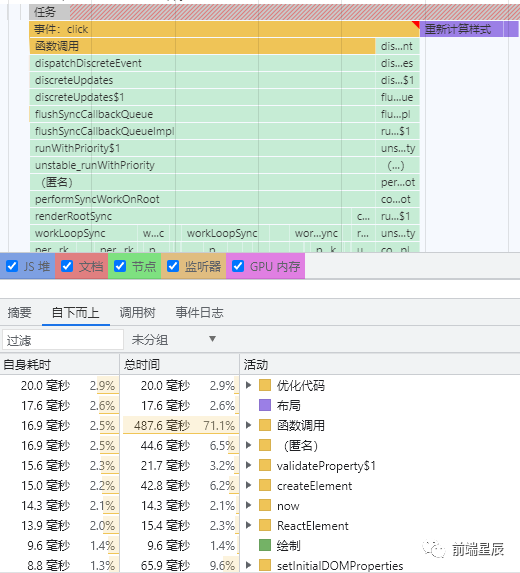【React】1138- React Hooks 性能优化的正确姿势
前言
React Hooks 出来很长一段时间了,相信有不少的朋友已经深度使用了。无论是 React 本身,还是其生态中,都在摸索着进步。鉴于我使用的 React 的经验,给大家分享一下。对于 React hooks,性能优化可以从以下几个方面着手考虑。
场景1
在使用了 React Hooks 后,很多人都会抱怨渲染的次数变多了。没错,官方就是这么推荐的:
我们推荐把
state切分成多个state变量,每个变量包含的不同值会在同时发生变化。function Box() { const [position, setPosition] = useState({ left: 0, top: 0 }); const [size, setSize] = useState({ width: 100, height: 100 }); // ... }这种写法在异步的条件下,比如调用接口返回后,同时
setPosition和setSize,相较于 class 写法会额外多出一次render。这也就是渲染次数变多的根本原因。当然这种写法仍然值得推荐,可读性和可维护性更高,能更好的逻辑分离。
针对这种场景若出现十几或几十个 useState 的时候,可读性就会变差,这个时候就需要相关性的组件化了。以逻辑为导向,抽离在不同的文件中,借助 React.memo 来屏蔽其他 state 导致的 rerender。
const Position = React.memo(({ position }: PositionProps) => {
// position 相关逻辑
return (
<div>{position.left}</div>
);
});因此在 React hooks 组件中尽量不要写流水线代码,保持在 200 行左右最佳,通过组件化降低耦合和复杂度,还能优化一定的性能。
场景2
class 对比 hooks,上代码:
class Counter extends React.Component {
state = {
count: 0,
};
increment = () => {
this.setState((prev) => ({
count: prev.count + 1,
}));
};
render() {
const { count } = this.state;
return <ChildComponent count={count} onClick={this.increment} />;
}
}
function Counter() {
const [count, setCount] = React.useState(0);
function increment() {
setCount((n) => n + 1);
}
return <ChildComponent count={count} onClick={increment} />;
}凭直观感受,你是否会觉得 hooks 等同于 class 的写法?错,hooks 的写法已经埋了一个坑。在 count 状态更新的时候, Counter 组件会重新执行,这个时候会重新创建一个新的函数 increment。这样传递给 ChildComponent 的 onClick 每次都是一个新的函数,从而导致 ChildComponent 组件的 React.memo 失效。
解决办法:
function usePersistFn<T extends (...args: any[]) => any>(fn: T) {
const ref = React.useRef<Function>(() => {
throw new Error('Cannot call function while rendering.');
});
ref.current = fn;
return React.useCallback(ref.current as T, [ref]);
}
// 建议使用 `usePersistFn`
const increment = usePersistFn(() => {
setCount((n) => n + 1);
});
// 或者使用 useCallback
const increment = React.useCallback(() => {
setCount((n) => n + 1);
}, []);上面声明了 usePersistFn 自定义 hook,可以保证函数地址在本组件中永远不会变化。完美解决 useCallback 依赖值变化而重新生成新函数的问题,逻辑量大的组件强烈建议使用。
不仅仅是函数,比如每次 render 所创建的新对象,传递给子组件都会有此类问题。尽量不在组件的参数上传递因 render 而创建的对象,比如 style={{ width: 0 }} 此类的代码用 React.useMemo 或 React.memo 编写 equal 函数来优化。
style 若不需改变,可以提取到组件外面声明。尽管这样做写法感觉太繁琐,但是不依赖 React.memo 重新实现的情况下,是优化性能的有效手段。
const style: React.CSSProperties = { width: 100 };
function CustomComponent() {
return <ChildComponent style={style} />;
}场景3
对于复杂的场景,使用 useWhyDidYouUpdate hook 来调试当前的可变变量引起的 rerender。这个函数也可直接使用 ahooks 中的实现。
function useWhyDidYouUpdate(name, props) {
const previousProps = useRef();
useEffect(() => {
if (previousProps.current) {
const allKeys = Object.keys({ ...previousProps.current, ...props });
const changesObj = {};
allKeys.forEach(key => {
if (previousProps.current[key] !== props[key]) {
changesObj[key] = {
from: previousProps.current[key],
to: props[key]
};
}
});
if (Object.keys(changesObj).length) {
console.log('[why-did-you-update]', name, changesObj);
}
}
previousProps.current = props;
});
}
const Counter = React.memo(props => {
useWhyDidYouUpdate('Counter', props);
return <div style={props.style}>{props.count}</div>;
});当 useWhyDidYouUpdate 中所监听的 props 发生了变化,则会打印对应的值对比,是调试中的神器,极力推荐。
场景4
借助 Chrome Performance 代码进行调试,录制一段操作,在 Timings 选项卡中分析耗时最长逻辑在什么地方,会展现出组件的层级栈,然后精准优化。
场景5
在 React 中是极力推荐函数式编程,可以让数据不可变性作为我们优化的手段。我在 React class 时代大量使用了 immutable.js 结合 redux 来搭建业务,与 React 中 PureComponnet 完美配合,性能保持非常好。但是在 React hooks 中再结合 typescript 它就显得有点格格不入了,类型支持得不是很完美。这里可以尝试一下 immer.js,引入成本小,写法也简洁了不少。
const nextState = produce(currentState, (draft) => {
draft.p.x.push(2);
})
// true
currentState === nextState;场景6
复杂场景使用 Map 对象代替数组操作,map.get(), map.has(),与数组查找相比尤其高效。
// Map
const map = new Map([['a', { id: 'a' }], ['b', { id: 'b' }], ['c', { id: 'c' }]]);
// 查找值
map.has('a');
// 获取值
map.get('a');
// 遍历
map.forEach(n => n);
// 它可以很容易转换为数组
Array.from(map.values());
// 数组
const list = [{ id: 'a' }, { id: 'b' }, { id: 'c' }];
// 查找值
list.some(n => n.id === 'a');
// 获取值
list.find(n => n.id === 'a');
// 遍历
list.forEach(n => n);结语
React 性能调优,除了阻止 rerender,还有与写代码的方式有关系。最后,我要推一下近期写的 React 状态管理库 https://github.com/MinJieLiu/heo,也可以作为性能优化的一个手段,希望大家从 redux 的繁琐中解放出来,省下的时间用来享受生活
